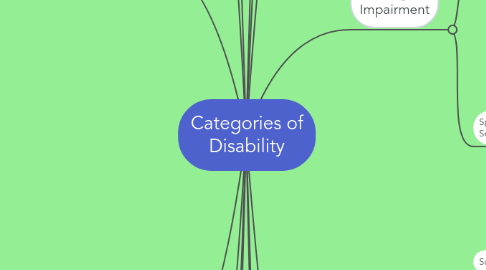
1. Autism
1.1. Subcategories of Pervasive Developmental Disorder
1.1.1. Autism
1.1.2. Asperger Syndrome
1.1.3. Rett Syndrome
1.1.4. Childhood Disintegrative Disorder
1.1.5. Pervasive Developmental Disorder Not Otherwise Specified
1.2. Interventions and Modifications
1.2.1. Early Intervention
1.2.1.1. Counseling and training for the family
1.2.1.2. Nutrition services
1.2.1.3. Psychological services
1.2.2. Special Education and School Services
1.2.2.1. Focus on improving communication
1.2.2.2. Offer social, academic, behavioral, and daily living skills training
1.2.2.3. Consistant and predictable classroom environment
1.2.2.4. Case Study: Josh
2. Developmental Delay
2.1. Subcategories
2.1.1. Physical development
2.1.2. Cognitive development
2.1.3. Communication development
2.1.4. Social or emotional development
2.1.5. Adaptive development
2.2. Assistive Technology
2.2.1. iPad or Android Apps to Improve Fine Motor and Cognitive Skills
2.3. Special Education and School Services
2.3.1. Notetaker
2.3.2. Individualized Education Plan
2.3.3. Visual Representation of Daily Schedule
2.3.4. Scaffolding
3. Emotional Disturbance
3.1. Subcategories
3.1.1. Anxiety Disorders
3.1.2. Bipolar Disorder
3.1.3. Conduct Disorders
3.1.4. Eating Disorders
3.1.5. Obsessive Compulsive Disorder
3.1.6. Psychotic Disorders
3.2. Assistive Technology
3.2.1. Behavior Chart
3.2.2. Points Sheet
3.2.3. Book of Possibilities
3.2.4. Talklight
3.2.5. Positive Reinforcement Games (iPad or Wii)
3.3. Special Education and School Services
3.3.1. Positive Behavioral Support
3.3.2. Counseling and Psychological Services
3.3.3. Individualized Education Plan
3.4. Case Studies
3.4.1. Bipolar Disorder
4. Intellectual Disability
4.1. Assistive Technology
4.1.1. Communication Boards
4.1.2. Communicators that Allow Students to Select Images to Express Their Thoughts
4.2. Special Education and School Services
4.2.1. Individualized Education Plan
4.2.2. Adaptive Skills Training
4.2.3. One-on-One Aide
4.2.4. Chunk Assignments
5. Multiple Disabilities
5.1. Causes
5.1.1. Chromosomal abnormalities
5.1.2. Premature birth
5.1.3. Difficulties after birth
5.1.4. Poor development of the brain or spinal cord
5.1.5. Infections
5.1.6. Genetic disorders
5.1.7. Injuries from accidents
5.2. Special Education and School Services
5.2.1. Wide Range of Abilities in this Category
5.2.2. Capitalize on Strengths of Student
5.2.3. Make Modifications Based on Abilities
5.2.4. Use a Combination of Strategies for Each Disability
6. Specific Learning Disability
6.1. Subcategories
6.1.1. Dyslexia
6.1.2. Dysgraphia
6.1.3. Dyscalculia
6.2. Assistive Technology
6.2.1. Recording Devices to Record Lectures
6.2.2. Speech to Text Software
6.2.3. Case Study: Joseph
6.3. Special Education and School Services
6.3.1. Chunk Large Assignments
6.3.2. Provide Both Verbal and Written Instruction
6.3.3. Organizational Skills Training
6.3.4. Individualized Education Plan
7. Traumatic Brain Injury
7.1. Assistive Technology
7.1.1. Talking Calendar or Clock
7.1.2. Pre-Recorded Reminders of Routine
7.2. Special Education and School Services
7.2.1. Give Additional Time to Complete Assignments
7.2.2. Give Additional Time to Complete Assignments
7.2.3. Give Directions One Step at a Time
7.2.4. Have Consistent Classroom Routines
8. Visual Impairment Including Blindness
8.1. Subcategories
8.1.1. Strabismus
8.1.2. Congenital Cataracts
8.1.3. Retinopathy of Prematurity
8.1.4. Retinitis Pigmentosa
8.1.5. Coloboma
8.1.6. Optic Nerve Hypoplasia
8.1.7. Cortical Visual Impairment
8.1.8. Blindness
8.2. Assistive Technology
8.2.1. Bold Markers for Writing
8.2.2. Dark-Lined Paper (Easier to See When Writing)
8.2.3. Large Print Calculator for Math Problems
8.2.4. Case Study: Mason
8.3. Special Education and School Services
8.3.1. Priority Seating
8.3.2. Notetakers
8.3.3. Readers
8.3.4. Individualized Education Plan
9. Deaf-Blindness
9.1. Assistive Technology
9.1.1. Assistive Listening Devices
9.1.2. Screen Braille Communicator
9.2. Special Education and School Services
9.2.1. Interpreters
9.2.2. Notetakers
9.2.3. Tutors
9.2.4. Readers
10. Deafness
10.1. Subcategories
10.1.1. Conductive hearing loss
10.1.2. Sensorineural hearing loss
10.1.3. Mixed Hearing Loss
10.1.4. Central Hearing Loss
10.2. Assistive Technology
10.2.1. Captioned Films/Videos
10.2.2. Jonathan Case Study
10.3. Special Education and School Services
10.3.1. Speech, Language, and Auditory Training from Specialists
10.3.2. Interpretor
10.3.3. Favorable Seating (to Facilitate Lip Reading
11. Hearing Impairment
11.1. Assistive Technology
11.1.1. Captioned Films/Videos
11.1.2. Amplification System
11.1.3. Hearing Aid
11.1.4. Case Study: Jean
11.2. Special Education and School Services
11.2.1. Priority Seating (Front of Classroom)
11.2.2. Reduce Classroom Noise
12. Orthopedic Impairment
12.1. Subcategories
12.1.1. Poliomyelitis
12.1.2. Bone Tuberculosis
12.1.3. Cerebral Palsy
12.1.4. Amputations
12.1.5. Contractures (caused by fractures or burns)
12.2. Assistive Technology
12.2.1. Speech Recognition Software
12.2.2. Screen Reading Software
12.2.3. Augmentative and Alternative Communication Devices (such as Communication Boards)
12.2.4. academic software packages for students with disabilities
12.2.5. Canes
12.2.6. Walkers
12.2.7. Wheelchairs
12.2.8. Specialized Chairs, Desks, and Tables
12.2.9. Case Study: Elle
12.3. Special Education and School Services
12.3.1. Physical Therapy Sessions
12.3.2. Speech and Language Development Help
12.3.3. Special Seating Arrangements to Develop Posture and Movements
12.3.4. Instruction Focused on Development of Gross and Fine Motor Skills
13. Other Health Impairment
13.1. Subcategories
13.1.1. ADD and AH/HD
13.1.2. Diabetes
13.1.3. Epilepsy
13.1.4. Heart Conditions
13.1.5. Hemophilia
13.1.6. Lead Poisoning
13.1.7. Leukemia
13.1.8. Nephritis
13.1.9. Rheumatic fever
13.1.10. Sickle Cell Anemia
13.1.11. Tourette syndrome
13.2. Assistive Technology
13.2.1. Voice Recognition Software
13.2.2. Speech to Text Software
13.2.3. Voice Recordings in Class
13.3. Special Education and School Services
13.3.1. Special Feedings
13.3.2. Clean Intermittent Catheterization
13.3.3. Medication Safely Dispensed
13.3.4. Conducting and/or Promoting Education and Skills Training for All (including the Child) who Serve as Caregivers in the School Setting.
14. Speech or Language Impairment
14.1. Subcategories
14.2. Assistive Technology
14.2.1. Augmentative or Alternative Communication (AAC)
14.2.2. Electronic AAC
14.2.3. First Words
14.3. Special Education and School Services
14.3.1. Meetings with Speech and Language Pathology Specialist
14.3.2. Individualized Education Plan

